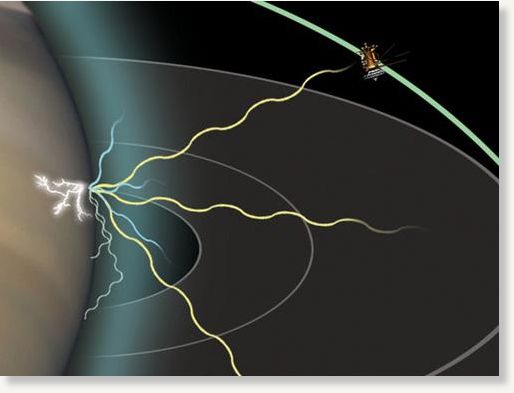
© NASA/JPL/University of Iowa
Scientists working with data from NASA's Cassini mission - now in its sixth year of operations at Saturn -
have discovered an electrical current running between Saturn and its moon Enceladus that creates an observable emission on the ringed planet.Don Mitchell, Cassini science team co-investigator from the Johns Hopkins University Applied Physics Laboratory, first observed the current connection as a strong "bull's-eye" emission in the middle of images snapped by the APL-built ion and neutral camera, known as INCA, on Cassini.
"The ion beam seen by the camera appears at exceptionally high energy, between about 30,000 and 80,000 electron volts - surprising for an interaction with such a small moon," said Mitchell, co-author of a paper on the research appearing in the April 21 issue of the journal
Nature.
This planet-moon connection also happens at Jupiter; Io, Europa and Ganymede all produce visible auroral footprints.
"Accurately identifying the magnetospheric location of a source of auroral emission is very exciting," said Chris Paranicas of APL, a Cassini scientist not directly involved with the study. "At Jupiter, the identification of the satellite footprints in the auroral region allowed scientists to connect the polar region with the equatorial one magnetically. This paper will give us a great reference point for future studies of Saturn's aurora."
The ion beam set the stage for APL's Abigail Rymer, a lead author of the study and a Cassini team scientist, to find evidence of a very strong co-aligned electron beam in Cassini plasma spectrometer data.
"I immediately pulled up the electron data and, sure enough, there was a very strong electron beam propagating away from Saturn toward Enceladus," Rymer said. "It was actually a fairly rare opportunity to capture that, since when Cassini flies close to a moon, we are generally looking at the moon, not away from it."
The electrons Rymer discovered were of sufficient energy that they could stimulate an observable auroral output on the planet, a glowing spot formed the same way as the Earth's northern lights - with electrons precipitating into the ionosphere. At Earth, however, the electrons come from interplanetary space; at Saturn, they represent an enormous current system looping through Enceladus all the way back to Saturn, more than 150,000 miles away.
Two weeks after the initial observations, with Cassini flying at higher latitudes, the ultraviolet imaging spectrograph captured three images of Saturn's ionosphere that included a visible glowing spot at exactly the expected location.
"We searched for an auroral footprint on Saturn by using Cassini's ultraviolet spectrograph to make images," said Wayne Pryor, the other study lead, of Central Arizona College. "It turns out that ultraviolet light from the Enceladus footprint is not always visible; in fact, of 282 images that could include the signal, only seven provide convincing evidence for a bright spot."
That the footprint appears to "flicker" suggests variable outgassing from Enceladus, Rymer said, but the Cassini team is not yet convinced the plume activity on Enceladus is variable.
"Scientists have been wondering whether the venting rate is variable, and these new data suggest that it is," Rymer said.
The Cassini-Huygens mission is a cooperative project of NASA, the European Space Agency and the Italian Space Agency. NASA's Jet Propulsion Laboratory, a division of the California Institute of Technology in Pasadena, Calif., manages the mission for NASA's Science Mission Directorate, in Washington, D.C. The ultraviolet imaging spectrograph team is based at the University of Colorado, Boulder. The magnetospheric imaging team is based at the Johns Hopkins University Applied Physics Lab, in Laurel, Md. The Cassini plasma spectrometer team is based at the Southwest Research Institute, San Antonio.For more information about the Cassini-Huygens mission, go to saturn.jpl.nasa.gov and www.nasa.gov/cassini.
"Don Mitchell, Cassini science team co-investigator from the Johns Hopkins University Applied Physics Laboratory, first observed the current connection as a strong "bull's-eye" emission in the middle of images snapped by the APL-built ion and neutral camera, known as INCA, on Cassini"
Where's the images?
Perhaps the moon isn't a moon at all but something else...